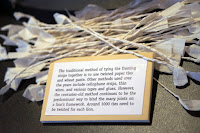Nestled in the Asian/Pacific Thematic Historic District of San Diego's Gaslamp Quarter is a great little museum. The Chinese Historical Museum is comprised of two buildings on opposite corners of Third and J. The original building used to be a mission building built in the 1920s to be an outreach and community center to the Chinese in San Diego at the time. Behind this building is a small Asian garden and fish pond.
Across the street the rotating exhibits are housed in the Dr. Sun Yat-Sen Memorial Extension. Just in time for the Chinese New Year (February 23 this year) a new exhibit opened featuring traditional new year prints, a small collection of tiger hats, a performance dragon, and a late entry to the lineup: the restored lion.
The curator, Alex Chuang, was kind enough to allow me to display the lion and as we emailed back and forth about the details the plan grew until I had to borrow a minivan to take all of the components down south. I'm glad Alex had the foresight to ask probing questions about how to go from, "Hi, I have something people might like to see" to a real museum-quality display.
Between the Hoi Gung ceremony and the museum display there was only a week to prepare everything including deciding what to display, how to arrange it, and all the signs to create. Good thing my wife and I love a challenge and work well under pressure.
So, here's what we came up with. Let me know what you think and if you get a chance, go see it in person. Pictures just don't convey the same scope as seeing it in real life.
Click any picture for a larger version.
It was fun trying to come up with a way to fit everything into the space requirement without it looking crowded. I was also trying to come up with some sort of order so the display would take the viewers through a logical progression of the project.Coming up with signage that would be interesting to both lion dancers who know their stuff and the general public was a bit of a challenge. Good thing my wife is an excellent editor! Figuring out where to place each sign in the display presented other issues as well.
The main display case is right at the entrance to the exhibit so you can't miss it. The frame in the second case is also from an old Lo On Kee lion around the same age as the restored one. Eventually it will also go through the restoration process.
The third case has a collection of parts showing the variety of pieces that make up a lion. Parts from a variety of lions and makers were chosen from my collection to show the similarities and differences.
The third case has a collection of parts showing the variety of pieces that make up a lion. Parts from a variety of lions and makers were chosen from my collection to show the similarities and differences.
One of the best comments I've gotten is from the museum staff who said that many people don't bother to read the signs on display pieces, but so far everyone has taken the time to read mine. Guess all the time and effort my wife and I put into them was worth it! Read on and let me know what you think.
There are a few signs that I didn't get good pictures of so if you want to read them all you'll have to go visit America's finest city and spend the $2 for admission to the museum. The rest of the exhibits are more than worth the price.
After this exhibit closes some other venues might be interested in displaying it down the line (details will be posted here if anything works out), but I don't have any set plans. If you know of a location or event that would be interested in showing it feel free to let me know.
































No comments:
Post a Comment